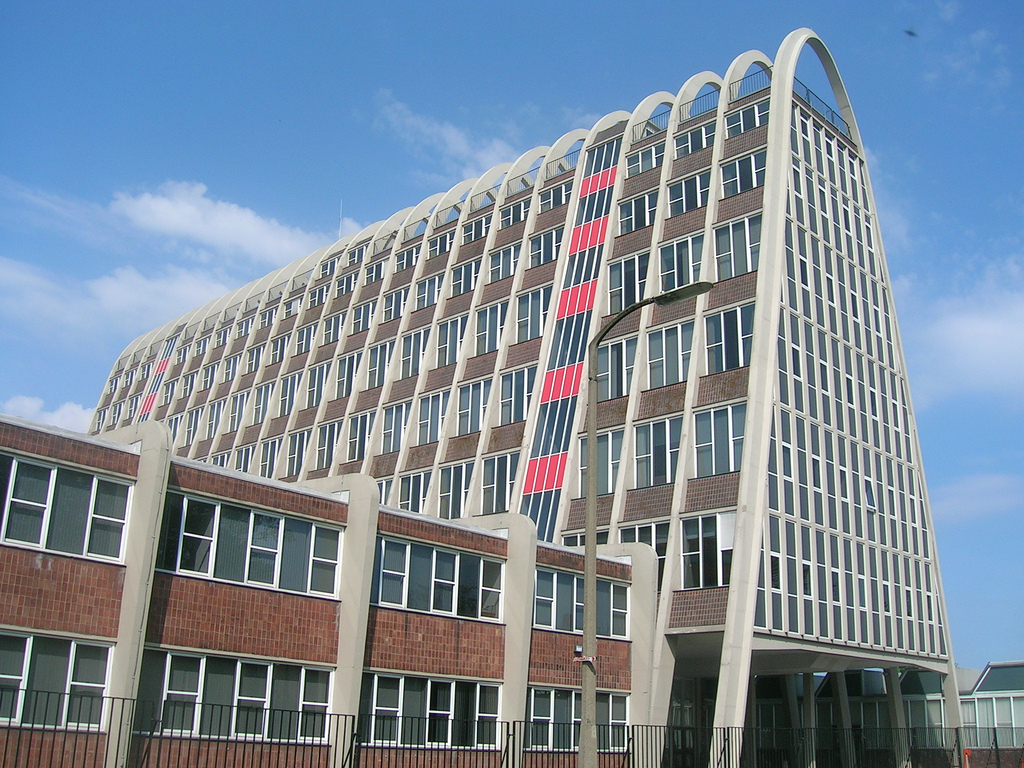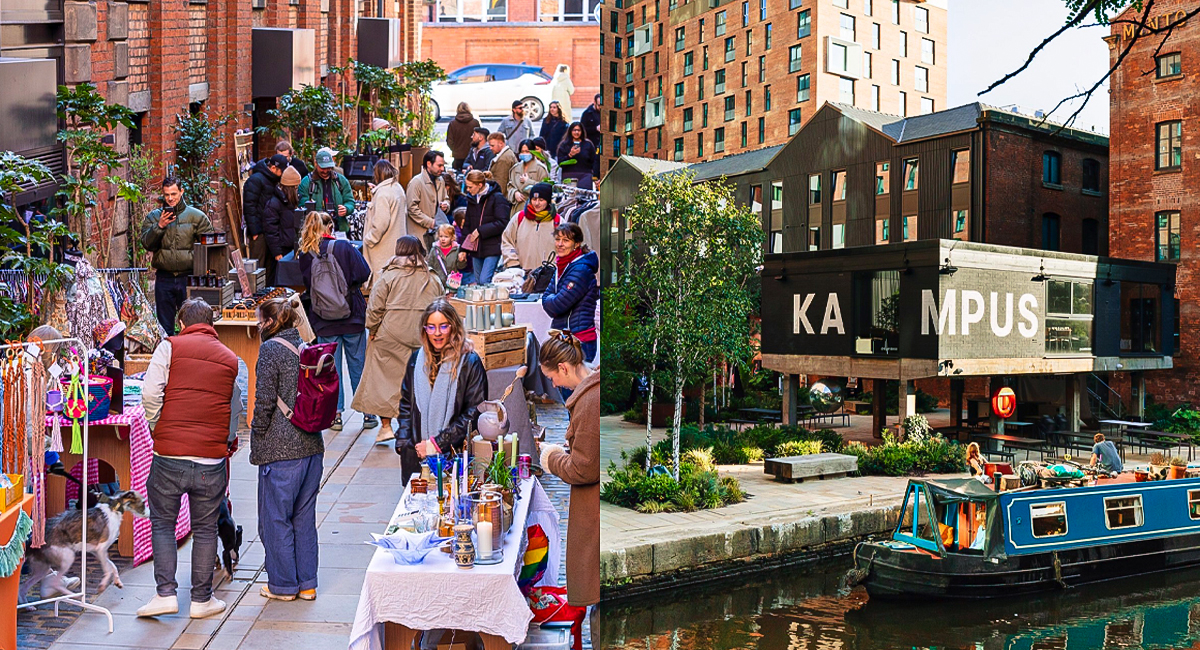It’s not just a recent phenomenon that sees buildings demolished to make way for future developments, it’s been going on in the city for hundreds of years.
Some of the time you don’t really appreciate what you’ve got until it’s gone, whereas others are celebrated when they get pulled down and quickly forgotten forever.
Here’s a selection of the city’s forgotten and long lost architectural and cultural gems, from a Brutalist double-sided tower, to a huge courthouse in Strangeways that was called “the most important building outside of Whitehall”.

Photograph by Mike Peel (www.mikepeel.net)
Mathematics Tower
A bizarre and imposing tower set right on Oxford Road, the UMIST Mathematics Tower always intrigued me back in the day with its unusual Brutalist beauty and frosty glass panelling. Constructed at the height of the concrete phenomenon in 1968, the tower was designed with two contrasting facades – a west side of concrete and an east of oddly angled glass. Each side was supposed to represent the current architectural movements of the era; modernism with flush glass panes and brutalism, marked by the use of concrete. With the merger of the Victoria University of Manchester and UMIST in 2004, the building was deemed ‘unfit for purpose’ and was demolished – much to the dismay of modernists around the world.

B of the Bang
A sculpture that was so beset by problems and flaws that it was dismantled and disappeared from our streets forever – within just a couple of years. Standing 56 metres tall on the corner of Ashton New Road and Alan Turing Way, B of the Bang was commissioned to mark the 2002 Commonwealth Games in the city and was the UK’s tallest until 2008. Not only was putting the sculpture together harder than constructing the LEGO Death Star without instructions, once it was completed it was 19 months late and cost twice as much. I still think it looked great though.
Spotlight on Statues: B of the Bang

Dickenson Road Studios
This production studio on Dickenson Road in Rusholme, housed in an old Methodist Church, was rather short lived and quickly forgotten, except for the small plaque that remains plonked onto the side of someone’s house to this day.Converted in 1947, the studios were home to Hammer Horror films, B-movies and was a linchpin to the formation of Granada Studios in the 50s. It became the first regional BBC Television studio outside London and is most-famously known as the location in which the first ever episode of Top of the Pops was broadcast. Presented by Jimmy Savile no less, and opening with The Rolling Stones performing “I Wanna Be Your Man”.

The Black Horse Hotel
While The Black Friar in Salford has benefitted from a fabulous new refurb and reinvention this year, lest us not forget the wonderful Black Horse Hotel down on CHapel Street, which was built all the way back in 1876. It was a listed building but stood empty for many, many years, and even though there were attempts to fix it up and repair its roof – it was finally demolished in 2017. CHapel Street has also been home to many a missed and forgotten pub, such as Ye Old Nelson and The Bell Tower, plus the lovely Matrix House – once home to The Old Bank Theatre.

Assize Courts
Widely admired over the years, Assize Courts has been referred to by many as one of Britain’s true ‘lost buildings’ and as such – deserves a spot on this list. It was a law courts down near Strangeways and for a good ten years back in the 1800 it was the tallest building in the city. When construction was completed in 1864, the nearby Strangeway Prison was included in the plans, and it was described as the most important building outside of Whitehall. Unfortunanely it was heaily bombed during the Manchester Blitz and stood decrepid and empty for a further 15 years before being demosilshed and lost forever.

The Royal Botanical Gardens
The ‘lost’ botanical gardens of Manchester, the only thing left of this place is the old entrance on the road to White City retail park. The gardens were home to the Manchester Botanical and Horticultural Society, with the 16-acre site being conveyed as “gardens for the recreation of the citizens of Manchester” and also to “further the scientific discipline of botany and horticulture…” They were home to a 40m high central conservatory, ornamental lake, a rockery , extensive lawns and even a fruit garden. After a significant decline in visitor numbers, the site was sold to a company called White City Limited in 1907 who turned it into an amusement park and dog track.
Building Secrets: The Lost Botanical Gardens of Manchester

Hotspur Press
Opened in 1849 the building mill producing cotton and textiles up until 1982 when Percy Brothers limited, a printing press company bought the building. The company ceased printing in 2011 and Percy Brothers Limited sold to a private investor. In recent years the building has been occupied by artists and has even been used to stage musical entertainment up until this year when the building closed for good. Since the building’s closure after 168 years of being open, the building was taken over by squatters until their eviction; the building is now back to being a vacant time warp.

Stevenson Square Underground Toilets
Who’d have known that there were toilets underground at Stevenson Square? Well, I would because I once went in them back in the day and they were GRIM. The small brick building with concrete steps running down into the underground is still visible today, but are now used for displaying some pretty trendy street art instead of providing a place to have a quick wee wee. Urban explorers have managed to squeeze in here over the years and get some pics, and my word – they’re even more creepy that when they were open.

The Toast Rack
Opened in 1960, The Toast Rack Building was the first building of its kind entering a new age of architecture with concrete towers beginning to grow across Manchester after the WWII. It gets its name from its distinctive design which looks very much like a toast rack (obviously), complete with a ‘fried egg’ on the smaller building in front. It gained Grade II listed status in 1998 the first of its type following the post-war architecture boom which began in the 1960’s. Made with a concrete frame and a brick infill on the bottom half of each storey this seven-story building is pretty infamous. Love it or hate it, it’s been stoody empty for years now – forgotten and a little bit sad.

Manchester Underground Market
With around 100 market stalls and shops, the Underground Market that used to be on Market Street was certainly nothing to be scoffed at. This subterranean Aladdin’s Cave was a shopper’s paradise for more than 15 years from the day it opened back in the Seventies. It was pretty well known for it’s small, dedicated clothing shops selling punk gear, a couple of great record shops and even a Stolen from Ivor – the jewel in the crown of any decent shopping area. It was a true independent haven, with one of the city’s best punk shops down there – Roxy – and it was a favoured place in which to buy yourself a nice new leather jacket and a pair of flairs. The whole thing lasted until 1989 when it was bricked up and, years later, half of it turned into the bottom floor of Tesco Metro – the place most city centre dwellers pick up their frozen chips, tins of Spaghetti Hoops and bog roll.

The Hippodrome
Like so many of the city’s theatres and cinemas, the historic Hippodrome was located right on Oxford Street. Opening up on Boxing Day in 1904, the theatre was an instant success, with luxurious features throughout, and a packed roster of performances and events. The Hippodrome was only rather short-lived however, especially in building terms – closing just over 30 years later in 1935. It was bought up by Bernstein Cinemas, who wanted to demolish it to make way for a picture house. INstead they used parts of the existing building and halfway through construction decided to sell it to Gaumont. Gaumont finished it and turned it into the Gaumont Cinema, which later became Rotters Night Club and is now an NCP car park.

Greengate Baths
Manchester’s ‘other’ forgotten Victorian baths, Greengate hasn’t received any of the attention that Victoria Baths ever has, and as a result is still rotting away just off Trinity Way in Salford. Built back in 1855 by one of Manchester’s greatest Victorian architects – Thomas Worthington – his other work in the city includes the Minshull Street Crown Courts on Ayton Street and the recently uncovered baths in Mayfield Park. The current state of the baths is shockingly bad, however with a huge development set to spring up here (called Greengate) – plans are still up in the air regarding this long-forgotten slice of Victorian life.

